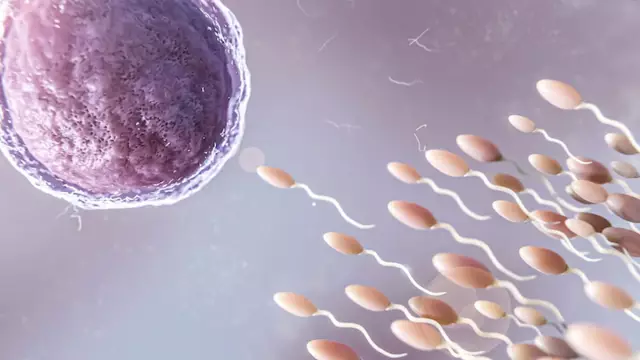- Author Rachel Wainwright [email protected].
- Public 2024-01-15 19:51.
- Last modified 2025-11-02 20:14.
Early menopause
The content of the article:
-
When menopause comes
- Period of premenopause
- Menopause period
- Postmenopausal period
- Why menopause comes early
- What happens in a woman's body
-
Signs of early menopause in women
- First symptoms
- Late symptoms
-
How to relieve the condition
- Symptomatic treatment
- Phytoestrogens
- Hormone replacement therapy
- Is it possible to prevent early menopause
- Video
In most cases, the first manifestations of menopause in a woman appear about 50 years old. However, in recent years, they increasingly talk about early menopause, the symptoms of which occur before the age of 45. This may be due to poor ecology, heredity, past gynecological and endocrine diseases. You can fight early menopause with hormone replacement therapy. Additionally, diet, herbal and medicinal preparations are used for treatment.
When menopause comes
The onset of menopause at the age of 45-55 is considered timely. However, the ovarian reserve can be depleted earlier, up to 40-45 years old, in this case we are talking about early or premature menopause. At the same time, regardless of age, menopause comes gradually, it can be divided into 3 stages - menopausal transition, menopause and postmenopause. An exception is artificial menopause, when the onset of menopause symptoms is associated with the removal of the uterus and appendages in the reproductive age.

They talk about early menopause when it comes before the age of 45
Period of premenopause
The menopausal transition is characterized by a gradual decrease in the production of estrogen by the ovaries; with early menopause, this period occurs up to 40 years. The female body is trying to adapt to a decrease in the production of sex hormones. The main sign of premenopause is menstrual irregularities - menstruation becomes irregular, cycle duration increases. At this stage, the first symptoms of menopause may appear - hot flashes, a violation of the psychological state.
Menopause period
Menopause is characterized by the cessation of menstruation. On average, menopause occurs at the age of 50, with early menopause - up to 45 years. Menopause lasts 1 year from the last menstrual period. During this period, the hormone-producing function of the ovaries fades, the level of estrogen in the blood decreases significantly. In this regard, a woman is worried about the climacteric syndrome - vasomotor and psychoemotional symptoms, disorders of the urogenital tract. Changes in metabolism occur, which often lead to weight gain.
Postmenopausal period
The postmenopausal period begins one year after the last spontaneous menstruation and lasts until about 70 years old, when the production of estrogen completely stops. At this stage, the body has already adapted to hormonal changes. Vasomotor and psychoemotional symptoms usually no longer bother, but the risk of damage to the cardiovascular system and bone tissue increases.
Why menopause comes early
Recently, more and more women are faced with the first manifestations of menopause before the age of 40. This can be due to many factors. The most common causes of early menopause include:
- Unfavorable ecological situation.
- Chronic effects of stress and emotional stress.
- Smoking and drinking alcohol.
- Hereditary predisposition.
- Gynecological diseases, especially ovarian pathology.
- Autoimmune pathology.
- Diseases of the endocrine system, including pathology of the thyroid gland and pituitary gland.
- Frequent childbirth and abortion.
- Taking hormonal and contraceptive drugs without direct indications.
The causes of artificial menopause, when hormonal changes in the body are associated not with ovarian depletion, but with the consequences of surgical intervention, are considered separately.
What happens in a woman's body
During reproductive years, most estrogen is produced by the ovaries. With the onset of menopause, the hormone-producing function of the ovaries decreases, but a small amount of estrogen is formed from androgens in adipose and muscle tissue. A lack of estrogen stimulates the hypothalamic-pituitary system - the production of follicle-stimulating (FSH) and luteinizing (LH) hormones increases.
Deficiency of estrogen affects, first of all, the state of the reproductive system - menstruation stops, reproductive function fades, libido decreases. However, estrogen receptors are found not only in the uterus and urogenital tract, but also in other organs - mammary glands, brain, bones, heart and blood vessels, skin.
Signs of early menopause in women
Sometimes the symptoms of early menopause are absent or mild. However, most women have climacteric syndrome, which not only lowers the quality of life, but can also lead to dangerous consequences. The development of all changes during menopause is associated with estrogen deficiency. Some symptoms appear already in premenopausal women, others make themselves felt after a few years.
First symptoms
Early symptoms occur even in premenopause, that is, before the age of 40. Often, the first sign of menopause that a woman encounters is hot flashes. Hot flashes appear as a sudden sensation of heat and sweating, followed by chills. The appearance of hot flashes is associated with vasodilation and a violation of thermoregulation. Other vasomotor phenomena often occur:
- dizziness;
- headache;
- redness of the skin of the face;
- excessive sweating;
- jumps in blood pressure.
In the early period, the psychoemotional sphere also suffers. Emotional lability appears when the mood changes dramatically in a short period. Tearfulness and irritability are characteristic, infuriates what a woman would not have paid attention to before. There is a breakdown, apathy, fatigue, even when doing ordinary things. Cognitive impairments develop gradually - it is difficult to memorize new information and fix attention.
Already during the menopausal transition, metabolism suffers, so a woman can rapidly gain weight. The appearance changes - the skin becomes less elastic, and the hair becomes dull.
Late symptoms
Late symptoms develop gradually over the years after menopause. All estrogen-dependent organs suffer, symptoms appear from the lower parts of the genitourinary system, heart and bone tissue. Metabolic disorders and skin changes become more pronounced.
| Symptom group | How do they manifest |
| Urogenital manifestations |
Lack of estrogen affects the condition of the mucous membrane of the urogenital tract - vaginal dryness appears, which leads to pain during intercourse. Atrophic changes in the mucous membrane of the bladder lead to frequent and painful urination. The vaginal microflora changes, which can cause burning, itching, and in some cases, the appearance of genital infections. The muscles in the pelvic floor are weakened, causing urinary incontinence. |
| Cardiological pathology |
With the onset of menopause, the risk of developing cardiovascular disease increases significantly. The elasticity of the vascular wall is lost, which, together with other factors, leads to arterial hypertension. Disorders of lipid and carbohydrate metabolism in postmenopausal women accelerate the development of atherosclerosis. In turn, arterial hypertension and atherosclerosis are the two most common causes of myocardial infarction and stroke. |
| Bone changes | The musculoskeletal system also suffers from estrogen deficiency. In postmenopausal women, the leaching of calcium from the bone tissue increases, as a result of which the bones become more fragile. These changes are the cause of osteoporosis and frequent fractures. |
How to relieve the condition
Menopause is a physiological period in a woman's life, therefore, it is impossible to restore the production of estrogen by the ovaries with the help of medications. Treatment of climacteric syndrome is aimed at alleviating the condition of a woman. For this purpose, drugs are used for symptomatic treatment, systemic hormone replacement therapy, phytoestrogen intake and lifestyle correction.
Symptomatic treatment
Some of the symptoms of menopause can be alleviated, and dangerous consequences can be prevented. For symptomatic treatment, medications are prescribed: antidepressants, bisphosphonates, local estrogens.
| The manifestation of climacteric syndrome | Drugs for treatment |
| Psycho-emotional disorders | To combat psychoemotional symptoms, antidepressants are prescribed - selective serotonin reuptake inhibitors (SSRIs). The dosage is selected individually by titration. Antidepressants can stop the symptoms of depression - improve mood, eliminate apathy, get rid of tearfulness and irritability. |
| Osteoporosis | Bisphosphonates, drugs that slow bone resorption, can help fight postmenopausal osteoporosis and prevent frequent fractures. Additionally, calcium and vitamin D supplements are recommended to strengthen bones. |
| Urogenital disorders | Local estrogens will help to get rid of vaginal dryness and painful sensations when urinating. The drugs are available in the form of vaginal suppositories, ointments and gels - Ovestin, Estrogel, Divigel. |
Phytoestrogens
To facilitate the course of menopause, you can use phytoestrogens, which are found in food or herbal preparations.
What foods should be increased in the diet:
- flax seeds;
- bran, whole grains;
- beans, chickpeas, lentils;
- green pea;
- fruits and berries.
Phytoestrogens improve a woman's overall well-being and relieve symptoms, but they are not able to cover all the body's needs.

Flax seeds contain phytoestrogens and may help manage some of the symptoms of menopause
Hormone replacement therapy
In severe menopause, systemic hormone replacement therapy is indicated. Women who have menopause early are prescribed two- or three-phase combined preparations containing estrogens and gestagens - Klimonorm, Klymen, Divina. These drugs mimic the normal menstrual cycle. With artificial menopause, hormone replacement therapy is carried out only with estrogens - Proginova, Ovestin, Estrofem are prescribed.
Taking systemic hormonal drugs compensates for the estrogen deficiency. This allows you to stop the signs of climacteric syndrome, improve skin condition, prevent the development of cardiovascular diseases and osteoporosis. However, systemic hormonal therapy also has disadvantages - the risk of thrombosis, malignant formations of the uterus and mammary glands significantly increases. Therefore, the decision to start substitution therapy is made individually, after a complete examination and weighing all the pros and cons.
Is it possible to prevent early menopause
It is impossible to prevent the onset of early menopause, but it can be delayed and symptoms relieved. To preserve their beauty and health, girls need to regularly undergo preventive examinations by a gynecologist, timely treat diseases of the endocrine system and genital organs. It is imperative to lead an active lifestyle, exercise (swimming, dancing, running, yoga), normalize sleep and allow yourself to rest. Diet will help to alleviate the manifestations of menopause - the content of phytoestrogens in the diet, as well as foods rich in calcium and vitamins, should be increased.
Video
We offer for viewing a video on the topic of the article.

Anna Kozlova Medical journalist About the author
Education: Rostov State Medical University, specialty "General Medicine".
Found a mistake in the text? Select it and press Ctrl + Enter.






